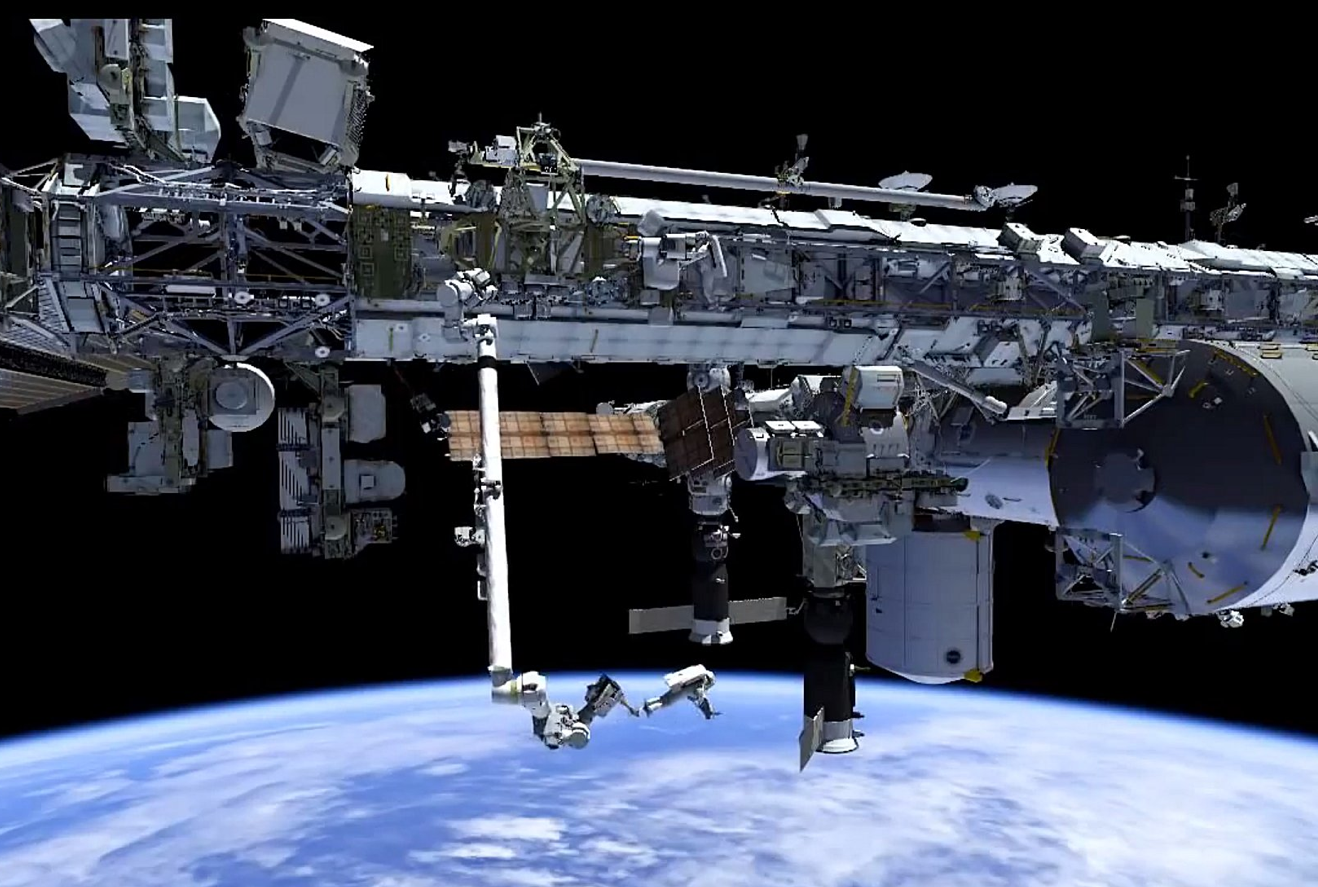
This is a highly accurate NASA digital simulation of what a spacewalk might look like from an imaginary camera away from ISS. You are only seeing a portion of Station. This gives you a good sense of the size of ISS. CLICK TO ZOOM
To Teachers: you can pass this post on to your students as a home activity, so they can see the International Space Station fly overhead at night with their parents and families. Also note that you can embed the ‘Spot the Station’ widget below on any website.
Right now the farthest humans from Earth are aboard the International Space Station, orbiting at an altitude of 270 miles (430 km) and moving at a speed of 17,100 mph (27,500 km/hr) – in other words, they are traveling 4.75 miles every second. That’s how fast you need to go to circle the Earth once every hour and a half.
There are 3 astronauts currently on Station, NASA Astronaut Chris Cassidy and Russian Cosmonauts Anatoly Ivanishin and Ivan Vagner. They have been up there for just 18 days. They launched on Soyuz MS-16 on April 9, 2020, from the Baikonur Cosmodrome in Kazakhstan. Here is a video of their launch:
In the column at right, there is a section that provides a photo of the astronauts, links to their biographies, a clock keeping track of how much time they have been on Station, and for Chris Cassidy links to his Instagram and Twitter accounts. He’s been posting photos of Earth from space and life aboard Station on Instagram. Follow him:)
You may not know this, but the International Space Station is the second brightest object in the night sky after the Moon, and has been flying over your head in plain sight (and likely unnoticed) for many years. You can easily find out when the Station will be flying over your home at night, how long it will be visible in your sky, and what direction to look to spot it coming over your horizon.
You are invited to use the ‘Spot the Station’ widget below to explore when the Station will be flying over your community, and you can even embed the widget on a website by clicking on the “About” button in the widget.
Some Things to Ponder
[hint – use the information provided at the top of this blog post, together with some research on the web]
How often do you see a sunrise or sunset? How often do the astronauts on the Space Station see a sunrise or sunset?
The International Space Station is in outer space. It is about 250 miles above the Earth. Can you think of a city or town 250 miles from you? That’s how far they are above your head.
Mt. Everest is the tallest mountain on Earth above sea level. How many Mt. Everests would you have to stack one on top of the other to reach the altitude of the International Space Station?
How many Empire State Buildings would you need to stack one on top of the other to reach the altitude of Station?
How much higher above Earth is the International Space Station compared to a commercial jet flying at 35,000 ft?
A History of The Widget
For many years, NASA’s Spot the Station website has been allowing the general public to determine when Station will be flying overhead, and it even allows you to sign up for email notification in advance of a Station over-flight of your community. In late 2015, in support of the Student Spaceflight Experiments Program, the National Center for Earth and Space Science Education suggested to NASA Headquarters that a Spot the Station widget, which could be easily embedded on any website, would be a wonderful way to extend ISS public awareness. The widget below was the result, and you’ll note that it is also found in the right column on all main pages of this SSEP website, and in the multimedia section on the SSEP Home page. We are grateful to NASA for creating this widget.
The Student Spaceflight Experiments Program (SSEP) is a program of the National Center for Earth and Space Science Education (NCESSE) in the U.S., and the Arthur C. Clarke Institute for Space Education internationally. It is enabled through a strategic partnership with DreamUp PBC and Nanoracks LLC, working with NASA under a Space Act Agreement as part of the utilization of the International Space Station as a National Laboratory. SSEP is the first pre-college STEM education program that is both a U.S. national initiative and implemented as an on-orbit commercial space venture.
The Smithsonian National Air and Space Museum, the International Space Station U.S. National Laboratory, and Subaru of America, Inc., are U.S. National Partners on the Student Spaceflight Experiments Program. Magellan Aerospace is a Canadian National Partner on the Student Spaceflight Experiments Program.




